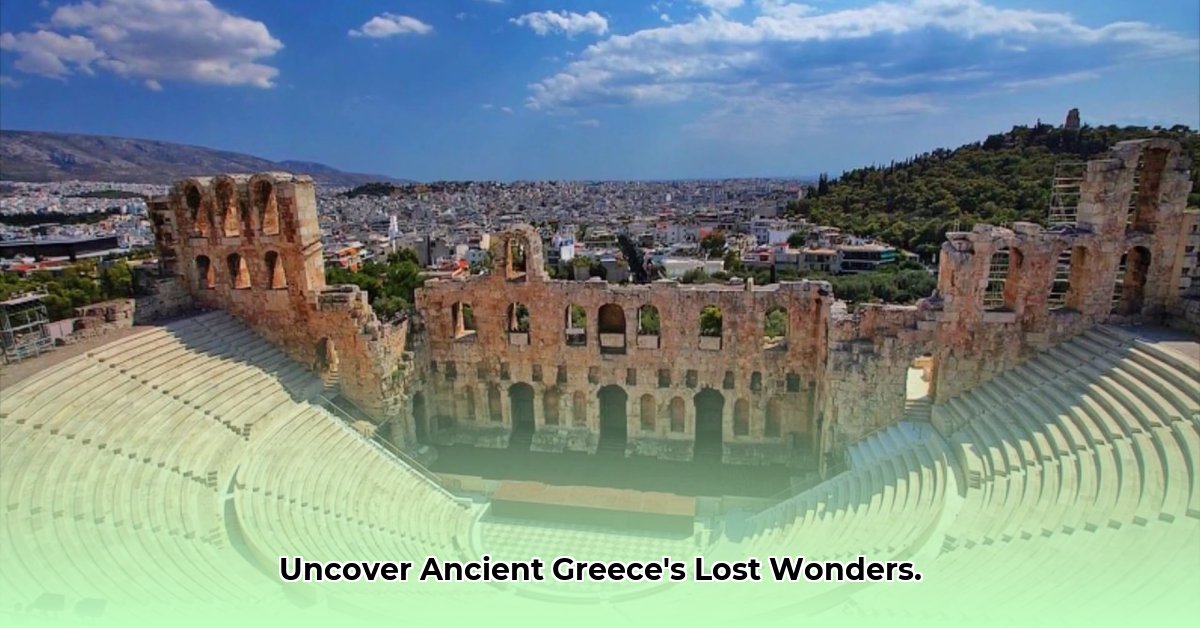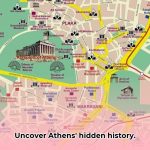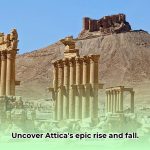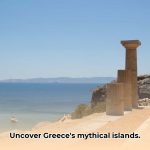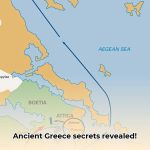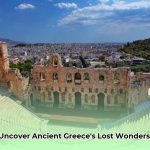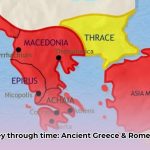Have you ever longed to wander amidst the echoes of ancient Greece? To imagine the grandeur of mighty temples, the vibrant energy of bustling marketplaces, and the presence of powerful gods? This isn’t just a history lesson; it’s an invitation to explore some of the most awe-inspiring locations on Earth. For a detailed map of Athens, check out this helpful resource: Athens map. Join us as we embark on a captivating tour of ancient Greece’s most iconic landmarks – from the renowned Acropolis to captivating, lesser-known sites – unveiling their remarkable stories and highlighting what makes each one profoundly special. Whether you’re a seasoned history enthusiast, a meticulous travel planner, or simply driven by curiosity, prepare for an unforgettable odyssey into the heart of ancient civilization!
Exploring Ancient Greek Landmarks: A Historical Journey
Prepare for an enthralling journey through time as we uncover the extraordinary landmarks that shaped ancient Greece. From vibrant city-states to revered sanctuaries, these sites provide a fascinating glimpse into a world brimming with myths, deities, and groundbreaking innovations. Let’s explore some of the most remarkable locations that continue to enthrall us, revealing hidden gems from the ancient world.
-
The Acropolis, Athens: A Hilltop Citadel of History: Envision yourself atop the Acropolis, towering above the sprawling tapestry of Athens. More than just a hill, this was the very epicenter of ancient Athenian life, a potent symbol of their civilization. The Parthenon, a majestic temple dedicated to the goddess Athena, commands the landscape with its iconic silhouette. Its colossal columns and incredibly intricate carvings bear witness to the extraordinary skills of ancient Greek artists and builders. Yet, the Acropolis encompasses far more than just the Parthenon; it’s an assembly of temples, monumental gateways, and formidable defensive walls, each echoing tales of a glorious past. Today, it endures as a timeless testament to democracy and Western civilization, an unmissable destination for every visitor to Greece. The sheer scale of the Acropolis and the breathtaking panoramic views it offers create an indelible memory.
-
Delphi: Where Gods Spoke and Destinies Unfurled: Venture to Delphi, cradled within the dramatic embrace of Mount Parnassus. The ancient Greeks revered this location as the very center of the world—the dwelling place of Zeus’s oracle. Here, among the evocative ruins of the Temple of Apollo, envision the Pythia, the high priestess, delivering prophecies that shaped the destinies of kings and entire cities. The sacred precinct overflowed with treasures from across the Greek world, illustrating the profound influence of religion on daily life. To explore Delphi today is to step back in time, to feel the profound weight of ancient Greek spirituality. It’s a truly mystical experience that lingers long after you depart.
-
Olympia: The Birthplace of the Olympic Games: There’s an undeniable allure to Olympia – the very birthplace of the Olympic Games. For centuries, this sacred site played host to athletic competitions and religious festivals. The remnants of the stadium, the temples, and the workshops conjure a vivid image of these ancient games, underscoring their vital role in ancient Greek culture and society. The Temple of Zeus, once home to a colossal statue of the king of the gods, stands as a testament to the site’s former splendor. Walking through Olympia today, one can almost hear the thunderous applause of the crowds and the rhythmic pounding of athletes’ feet.
-
Mycenae: Unearthing a Lost Civilization: Plunge into the world of the Mycenaeans, a civilization predating classical Greece, to glimpse into the Bronze Age. Mycenae, a formidable fortress, unlocks the secrets of this powerful Bronze Age culture. The awe-inspiring Lion Gate, the immense Cyclopean walls, and the regal tombs reveal their remarkable architectural and engineering skills. The discovery of the Mask of Agamemnon, while its true owner remains a topic of scholarly debate, heightens the mystery and wonder surrounding this significant archaeological site. Researchers continue to analyze the findings, constantly refining our understanding of this captivating period in Greek history.
-
Knossos: Palace of the Minoans: Journey to Knossos, the magnificent palace of the Minoan civilization on the island of Crete. This site unveils an astonishingly advanced and vibrant culture that flourished even before the Mycenaeans. Its labyrinthine network of rooms, intricate frescoes, and sophisticated plumbing systems reveal a society far ahead of its time. While numerous mysteries persist, the sheer scale and artistry of the ruins never fail to captivate. Ongoing excavations promise further insights into the Minoans’ lives and achievements. Some scholars propose that their influence extended far beyond the island, profoundly shaping the development of later civilizations in the Aegean.
-
Delos: Island of Light and Commerce: Delos, a small island in the Cyclades, holds immense historical and mythological significance. According to Greek mythology, it was the birthplace of Apollo and Artemis. In antiquity, Delos became a major religious center and later a bustling commercial hub. The Sanctuary of Apollo attracted pilgrims from across the Greek world, while its strategic location made it a crossroads for trade. Today, visitors can explore the well-preserved ruins of temples, sanctuaries, and merchant houses, offering a glimpse into the island’s rich past.
-
Meteora: Monasteries in the Sky: This UNESCO World Heritage site in Thessaly features a collection of Eastern Orthodox monasteries perched atop towering rock formations. The monasteries, built by monks seeking solitude and spiritual refuge, offer breathtaking views of the surrounding landscape. Visitors can climb winding paths and staircases to explore these unique structures, marveling at their architecture and the dedication of the monks who built them. Meteora is a testament to human ingenuity and the enduring power of faith.
-
Ancient Epidaurus: Sanctuary of Healing: This ancient site in the Peloponnese was renowned for its sanctuary dedicated to Asclepius, the god of healing. Pilgrims from across the Greek world flocked to Epidaurus seeking cures for their ailments. The site features a remarkably well-preserved theater known for its exceptional acoustics. Visitors can also explore the ruins of temples, baths, and other structures associated with healing and wellness. Epidaurus offers insights into ancient Greek medicine and the importance of holistic health practices.
-
The Temple of Olympian Zeus, Athens: Venture into the heart of Athens to witness the grandeur of the Temple of Olympian Zeus, also known as the Olympieion. This colossal temple, dedicated to Zeus, the king of the gods, was one of the largest in the ancient world. Construction began in the 6th century BC but was not completed until the reign of Roman Emperor Hadrian in the 2nd century AD. Today, only a few towering columns remain, offering a glimpse into the temple’s former splendor. The Temple of Olympian Zeus stands as a symbol of ancient Greek ambition and architectural prowess.
-
Ancient Corinth: This ancient city, located on the Isthmus of Corinth, played a vital role in ancient Greece due to its strategic location and thriving commerce. Explore the ruins of the Temple of Apollo, the Roman Forum, and the Bema, where Saint Paul is said to have addressed the Corinthians. The nearby Acrocorinth, a towering rock formation, offers panoramic views of the surrounding landscape and served as a formidable fortress in antiquity. Ancient Corinth provides insights into the economic, political, and religious life of ancient Greece.
-
Preservation Challenges and the Future of Ancient Wonders: The preservation of these extraordinary sites presents an ongoing challenge, demanding innovative solutions and dedicated resources. Archaeologists actively work to unearth new knowledge, while conservation efforts tirelessly safeguard these irreplaceable treasures. Sustainable tourism plays a critical role in ensuring these locations remain accessible for generations to come. We can all contribute by supporting responsible travel practices, advocating for their protection, and contributing to ongoing research. The future of these majestic landmarks relies on our collective commitment to their preservation. Much remains to be discovered about ancient Greece, and new discoveries are continuously adding layers of understanding, enriching the historical narrative.
Table: A Snapshot of Ancient Greek Landmarks
| Landmark | Location | Significance | Key Features |
|---|---|---|---|
| Acropolis of Athens | Athens | Center of Athenian life, symbol of democracy | Parthenon, Erechtheion, Propylaea |
| Delphi | Mount Parnassus | Religious center, oracle of Apollo | Temple of Apollo, sacred precinct, theater |
| Olympia | Elis | Birthplace of the Olympic Games | Stadium, temples, workshops |
| Mycenae | Peloponnese | Powerful Bronze Age civilization | Lion Gate, Cyclopean walls, royal tombs |
| Knossos | Crete | Center of Minoan civilization | Palace, frescoes, advanced plumbing systems |
| Delos | Cyclades | Mythological Birthplace of Apollo and Artemis, Commercial Hub | Temples, Sanctuaries, Merchant Houses |
| Meteora | Thessaly | Monasteries on Rock Formations | Byzantine Monasteries perched on towering rock pillars |
| Ancient Epidaurus | Peloponnese | Sanctuary of Healing | Well-preserved theatre renowned for exceptional acoustics |
| Temple of Olympian Zeus | Athens | Colossal Temple Dedicated to Zeus | Towering Columns displaying ancient Greek ambition and architectural prowess |
| Ancient Corinth | Isthmus of Corinth | Strategic City due to Location and Commercial Hub | Temple of Apollo, Roman Forum, Bema |
This journey through ancient Greece merely scrapes the surface of the wonders awaiting discovery. Each site holds unique stories and insights waiting to be explored. Further research promises to reveal even more details about their history, construction, and the lives of the people who inhabited them, enriching our understanding of this remarkable civilization. So, venture forth, explore, and uncover the enduring legacy of ancient Greece, and contemplate the significance of sustainable tourism practices!
How to Plan a Sustainable Tourism Itinerary for Lesser-Known Ancient Greek Sites
Key Takeaways:
- Emphasize minimizing your environmental footprint through the adoption of responsible travel habits.
- Support local economies and communities through mindful purchasing and engagement.
- Familiarize yourself with the sites prior to your visit to enhance your experience and demonstrate respect for their cultural significance.
Unveiling Hidden Gems: Beyond the Acropolis
Ancient Greece beckons with its well-trodden paths, but what if you yearn for something more? What if you wish to uncover the secrets this magnificent civilization holds beyond the main attractions? This is where How to Plan a Sustainable Tourism Itinerary for Lesser-Known Ancient Greek Sites becomes essential. Let’s explore some hidden gems, emphasizing responsible travel practices to ensure these sites remain preserved for future generations.
Discovering the Undiscovered: A Sustainable Approach
Planning a trip to lesser-known sites requires thoughtful consideration of sustainability. It’s about more than just visiting landmarks; it’s about respectful and responsible exploration. How can we ensure our journey leaves a positive impact, rather than a damaging one, on the environment and local communities?
Here are actionable steps to assist you in planning your sustainable trip:
-
Research: Before booking any flights, thoroughly research potential destinations. Look past the typical tourist spots and consider integrating local communities into your itinerary. Explore destinations such as the ancient city of Philippi (Macedonia), renowned for its Roman ruins and early Christian history, or the Sanctuary of Asclepius at Epidaurus, celebrated for its exceptional acoustics, to immerse yourself in the local culture.
-
Transportation: Minimize your carbon footprint by prioritizing train travel, often preferable to flying, particularly when traveling between cities, and by supporting local transportation efforts. Within regions, consider using local bus services or carpooling to lessen your environmental impact. Remember, walking grants unparalleled intimate encounters with the landscape, granting you the ability to explore at your own rhythm.
-
Accommodation: Opt for eco-friendly accommodations that incorporate renewable energy. Seek out hotels or guesthouses committed to sustainable practices – solar power, water conservation, locally sourced food – to minimize environmental effects. Consider staying in smaller, family-run establishments; you’ll directly support local communities.
-
Local Engagement: Support local businesses by patronizing local tavernas and restaurants. Eat at local tavernas and consume locally sourced food. Purchase souvenirs from local artisans, and hire local tour guides. This strengthens the local economy and preserves their cultural heritage, protecting the very essence of what you’re traveling to experience.
Examples of Sustainable Exploration
Let’s examine specific instances of sustainable exploration practices:
-
Ancient Messene: This remarkably well-preserved city in the Peloponnese offers a profound glimpse into daily life in ancient Greece. Explore its impressive walls, theaters, and agora while minimizing waste. Consider a guided tour conducted by a local operator, thus guaranteeing your money directly benefits the local community and supports local businesses.
-
Dion: Located near Mount Olympus, Dion once served as a vital religious and cultural hub. Explore its temples, theaters, and intricate mosaics. Arrange your visit during the off-season to circumvent overcrowding and support local businesses during slower periods, minimizing the negative effects of mass tourism.
-
Delphi: Although more widely recognized, Delphi can still be experienced sustainably. Consider hiking up to the sanctuary as opposed to taking a taxi, thereby limiting your emissions. Support local restaurants and shops, fortifying the local economy. Remember, utilizing reusable water bottles significantly lessens plastic consumption.
Sustainable Travel: A Legacy of Responsibility
It is crucial to remember that it is not solely about which sites you explore, but also about the environmental impact you leave on the environment and native communities. By embracing sustainable practices, you contribute to the preservation of these invaluable historical treasures for generations that follow. Your journey evolves into a tale of exploration coupled with responsible stewardship for future visitors and the long-term sustainability of global tourism.
A Guide to Best Practices for Archaeological Tourism
Preservation Tactics for Ancient Greek Sites: A Conservationist’s Guide
Key Takeaways:
- Ancient Greek sites confront many threats, including natural erosion, seismic activity, and the effects of human activity.
- Preservation Tactics for Ancient Greek Sites: A Conservationist’s Guide encompass a diverse strategy fusing traditional methods with state-of-the-art technology.
- Modern technology fulfills a pivotal role in site preservation and analysis, facilitating thorough documentation and non-invasive assessments.
- Community involvement and sustainable tourism remain critical for long-term success, ensuring that preservation initiatives benefit local populations and economies.
- Collaboration between governments, researchers, and local communities is vital for coordinated and efficacious preservation strategies that safeguard these invaluable cultural assets.
The Acropolis: A Balancing Act
Envision standing on the Acropolis, taking in the panoramic views of Athens,. The Parthenon, serves as a symbol of ancient Greek ingenuity. However, its beauty conceals a persistent battle—to preserve it against weathering, pollution, and the sheer impact from numerous tourists. How can we balance preserving this historical marvel whilst allowing the world to immerse in its magnificence? It is a delicate equilibrium necessitating careful planning and innovative solutions.
Here, preservation efforts range from structural reinforcement, to scrupulous cleaning of the Pentelic marble to protect it from acid and corrosion. Experts use state-of-the-art technology like laser scanning to construct digital twins, thus enabling virtual preservation and detailed analyses of damage without physically touching the original structure. Further efforts are focused on minimizing tourist impact by restricted access and educational programs to encourage responsible visitation.
Olympia: Unearthing the Games
Olympia, birthplace of the Olympic Games, echoes narratives of athletic prowess and religious devotion. However, its ruins encounter a unique set of challenges. The site’s vastness dictates strategic planning for preservation initiatives, and the fragile characteristics of unearthed artifacts demand skillful handling and storage to expand their lifespan.
Preservation strategies concentrate on responsible excavation practices, cautious artifact storage in climate-controlled environments, and preventative conservation measures to mitigate future damage. Archaeologists apply advanced techniques such as 3D modeling to carefully document the site’s present state, thereby allowing future generations to trace its evolution and guiding specific restoration initiatives. This meticulous approach ensures the history of the Olympic Games continues to inspire wonder for the future.
Delphi: A Sacred Mountain’s Challenges
Nestled on Mount Parnassus, Delphi once served as the focal point of the ancient world’s ecclesiastical life. Today, its ruins face the rigors of its elevated position – severe weather conditions such as strong winds and torrential rain, in addition to seismic activity, which can destabilize ancient structures. In spite of these challenges, the treasures and historical importance of Delphi withstand.
Here, preservation tactics center on safeguarding the location from erosion and weathering via landscape management and strategic drainage methods. Careful stabilization methodologies, such as grouting and reinforcement of weakened structures, avert additional damage, preserving the ancient temples and theaters. Sustainable tourism approaches are equally essential, lessening the impact of visitors to these sacred grounds via designated pathways and visitor education programs.
Technological Advancements: A Modern Shield
Consider 3D modeling as the means to construct a flawless digital duplicate of a site, providing a non-invasive manner to study and protect cultural heritage. This empowers experts to evaluate destruction without physically interacting with fragile artifacts, minimizing the risk of any further degradation. Laser scanning generates remarkably detailed images of surfaces, documenting minute details invisible to the naked eye and assisting in damage assessments. Then, GIS (Geographic Information Systems) aids in the organization of all this data, giving a thorough overview of the site’s attributes, and facilitating spatial research for preservation planning. These instruments aid in scheduling restorations, allowing for targeted interventions that minimize disruption and maximize the effectiveness of conservation efforts.
| Technology | Application | Benefits |
|---|---|---|
| 3D Modeling | Virtual reconstruction, damage assessment, scheduling restorations | Non-invasive analysis, detailed documentation, facilitates collaborative work |
| Laser Scanning | High-resolution imaging of surfaces | Precise measurements, detection of minute damage, enables targeted interventions |
| Geographic Information Systems (GIS) | Site management, data visualization, spatial analysis | Efficient data management, spatial planning for preservation and tourism |
A Collaborative Endeavor
Preserving ancient Greek sites extends beyond the work completed by archaeologists; it is a collaborative endeavor involving numerous stakeholders and communities. Governments furnish funds and regulations to sustain preservation initiatives and guarantee compliance with cultural heritage laws. Local communities welcome the opportunity to embrace their heritage and actively participate in preservation initiatives, contributing local knowledge and expertise. Tourists transform into responsible stewards by appreciating site regulations, sustaining local businesses, and minimizing their environmental footprint. These partnerships are vital to ensure these distinct landmarks remain a legacy and foster a sense of shared responsibility.
Sustainable Tourism Strategies for Ancient Greek Landmarks
Key Takeaways:
- Integrating ancient Greek principles of environmental respect and mindful travel into modern tourism practices is crucial for sustainability, aligning with the values of ancient culture.
- Balancing economic benefits with preservation is essential for long-term viability, ensuring that tourism contributes to the local economy without compromising cultural heritage.
- Collaboration between governments, businesses, and local communities is needed for effective Sustainable Tourism Strategies for Ancient Greek Landmarks, fostering a shared responsibility for preservation.
- Tourists have a responsibility to practice responsible travel, respecting local cultures and minimizing environmental impact to contribute to the sustainability of ancient sites.
The Acropolis of Athens: A Model for Sustainable Tourism
Envision yourself present on the Acropolis, captivated by the Parthenon, yet aware of how over-tourism precipitates destruction and damage within the site. It’s awe-inspiring, isn ‘t it? However, this iconic landmark faces concerns stemming from over-tourism, with frequent degradation of historical structures. How can we further ensure that preservation goes hand in hand whilst still allowing guests to experientially witness its grandeur responsibly? This is where Sustainable Tourism Strategies for Ancient Greek Landmarks commences and necessitates a multi-faceted approach. We are pressed to manage the visitor numbers through timed entry systems or designated routes to reduce congestion & damage. Moreover, investment in better infrastructure, such as public transportation and more accessible pathways, lessens environmental impact and heightens visitor experience. Supporting local businesses further ensures that the local community benefits from tourism, giving rise to a symbiotic relationship between preservation and economic growth.
Delphi: Ancient Sanctuary, Modern Stewardship
Delphi, the ancient sanctuary of Apollo, also provides a poignant case of sustainable considerations. Its breathtaking setting and historical significance attract thousands of tourists annually, thereby placing a strain on the fragile environment and infrastructure. But how do we best protect this fragile ecosystem while still permitting the immersive spiritual natures of its sacred spaces? Measures, such as more strict waste management protocols incorporating recycling and composting initiatives, coupled with more responsible construction practices that minimize environmental disturbance, are critical. Educating tourists about the site importance, promoting responsible behavior, and highlighting cultural and ecological worth is equally crucial. This educational approach represents a key component of effective **Sustainable Tourism Strategies for Ancient Greek Landmarks, which ensures that site history enhances its visitor experience rather than compromising it.
Olympia: Celebrating the Games Responsibly
Olympia, the birthplace of the Olympic Games, while captivating, demands an immense amount of careful management to ensure its prolonged sustainability. Here, we ought to consider the long-term impacts of mass tourism. Should we implement more green initiatives, such as renewable energy sources used to power the site’s facilities, and effectively reduce its carbon footprint? Encouraging support of local craftspeople and artisans could potentially construct more authentic and enriching experiences for visitors, whilst contributing to the local economy – a vital aspect of viable Sustainable Tourism Strategies for Ancient Greek Landmarks, fostering economic resilience. Contemplate how sustainable practices become integral to the modern Olympic spirit, promoting ecological and social responsibility?
Knossos: Protecting Minoan Heritage
Knossos, with its marvelous Minoan Palace, demands scrupulous preservation, in order to protect its delicate archaeological remains from degradation and visitor impact. The fragile characteristics of its archaeological remains and cultural significance also demand that there are strict rules on visitor movement and access restrictions to prevent damage. Investing in research and preservation efforts is vital for its long-term survival, which ensures that future generations also appreciate these unique pieces of history. The implementation of robust Sustainable Tourism Strategies for Ancient Greek Landmarks at sites like Knossos includes such initiatives as the promotion of environmentally sound transport options for visitors and the further support of local businesses. These places show more than just simple ruins; rather, they remain living histories, providing invaluable insights into human civilization.
Implementing Sustainable Practices: A Collaborative Effort
In this case, success is contingent upon collaboration and the shared responsibility amongst varying shareholders or communities. It is pivotal that governments create and enforce any regulations, establishing standards for any sustainable tourism practices and preserving our cultural heritage. Businesses are required to adopt some sustainable practices, turning toward using and sourcing ethical renewable energy from reduction-focused approaches. Furthermore, local communities ought to also be involved in crafting tourism strategies, in order to ensure an equitable benefit distribution and greater community empowerment. And, lastly, tourists also begin to play a more vital role through choosing more sustainable options, respecting local cultures, and minimizing broader impacts, becoming active in preserving Greece’s heritage. We become shareholders for incredible landmarks by safeguarding to future generations.
- Uncover Ancient Arcadia: Myths, Power, and Geography - August 12, 2025
- Explore Ancient Olympia’s Map: Unveiling 2,500 Years of History - August 12, 2025
- Discover Ancient Greece’s Islands: A Timeless Journey Through History and Myth - August 12, 2025
